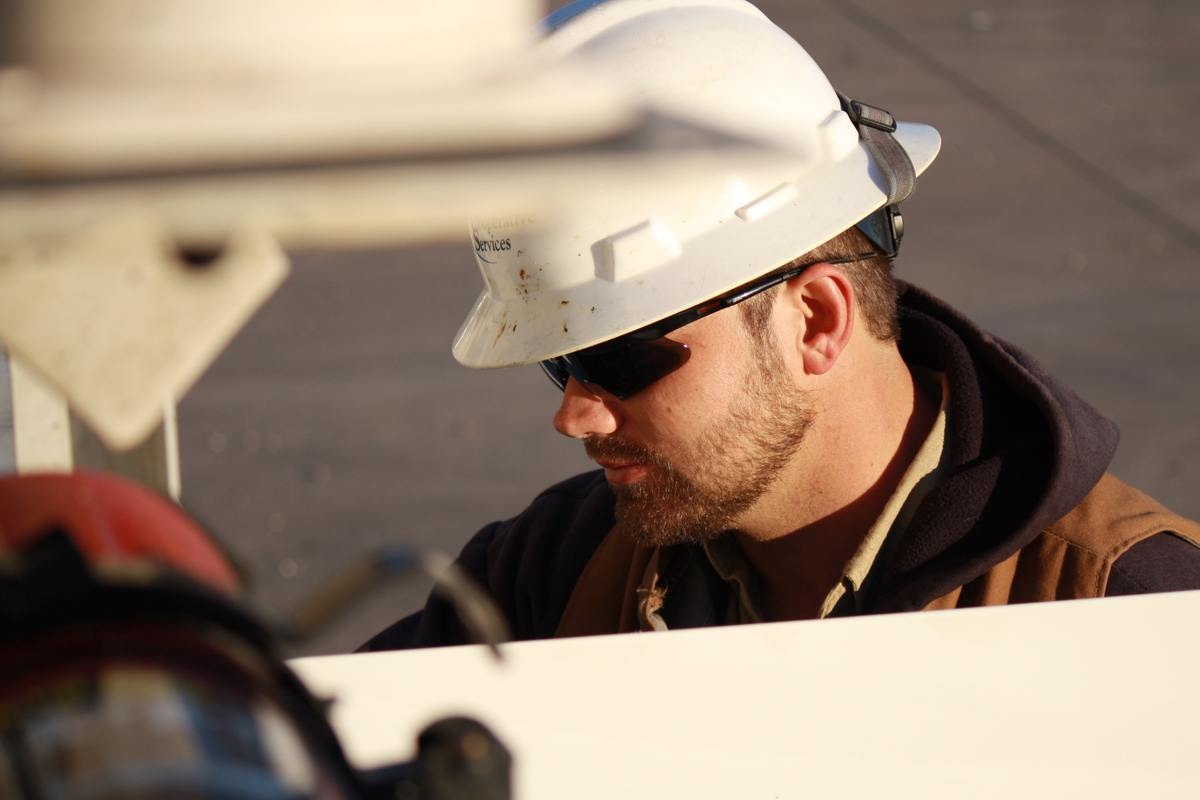Just as he returned home from a hunting trip, he had to turn around and go to work.
Joel Jernigan, an apprentice lineman III at United Cooperative Services, had spent the weekend with his fellow linemen hunting geese in Haskell. He and his colleagues knew about the probable inclement weather on its way, but had no idea what lay in store that Sunday in January.
What started as a foggy drizzle Jan. 15 ended in two storms colliding, 70 mile-per-hour winds, driving rain, flash flooding and tornadoes for parts of United’s service territory. Though United had fewer outages than other service providers, the high winds and driving rain kept United employees hopping.
Jernigan was just one of the dozens of United crew members who braved the elements and worked long hours to bring the 1,400 outages across the 14-county service territory back online.
“We got back and then had to pack up for work,” he said. “I knew it was coming, but I didn’t know it was going to be that bad. I thought it would be more drawn out over the weekend, not just one hard storm. When a storm comes through like this, it’s all hands on deck.”
Originally assigned to replace a blown transformer in Burleson, a surprise storm that blew northeast from Alvarado and Venus had affected a substation serving a large area around Mansfield. As he and his crew arrived to restore power, a second storm blew through, dumping rain and blowing fierce winds.
As he and others worked and drove through the area, they witnessed a swift water rescue in a nearby creek.
Texans always have known the weather can change on a dime, and perhaps a January tornado isn’t completely unheard of. However, the storm served as a good reminder that members should prepare for the worst when it comes to enduring nature’s fury.
Little known fact, said Chris Coleman, Electric Reliability Council of Texas (ERCOT) senior meteorologist, is that it’s actually more common for Texas to have a tornado in January than it is in July due to summertime jet stream changes. He also said tornadoes are more likely in January than in December or February.
“That’s a weird anomaly,” Coleman said. “The only thing I can come up with for why is the January thaw. The normal temperatures in the eastern two-thirds of the country bump up a little bit in January. So, this mid-winter warming may cause a slight increase in tornadoes.”
Coleman, who has watched the weather since November to predict an overall spring weather forecast for his report due out in March, cautioned that his current predictions might not yet be completely accurate. However, early indications call for above-normal temperatures and precipitation for all of Texas, including the United service area.
No solid scientific method exists for long-range tornado prediction in the same way that one exists for, say, hurricane season, he said. However, if he looks back historically at spring times in years that reflect what he is predicting for this spring’s temperatures and precipitation, Coleman believes the state could have an average number of tornadoes this year.
“For the whole state of Texas, the numbers I’m seeing don’t support a prediction for any more tornadoes than normal,” he said. “And on an average in a normal year, we see 146.”
There’s never been a year on record with zero tornadoes for North Texas, Coleman said, and all residents should consider making preparations for the March-June tornado season.
Whether ice storms, tornadoes or other natural disasters, David Stone has seen them all as well. And, he’s also seen how many people don’t prepare adequately for the possibilities until it’s too late.
In the same way the best offense is a strong defense, the United safety training/loss control director said prior planning for catastrophic events is key to enduring Mother Nature’s fury.
“The first thing would be to have flashlights and fresh batteries, candles and a good supply of bottled water and non-perishable food,” he said. “Also, put your utility’s phone number into a cell phone beforehand rather than writing it on a piece of paper and sticking it on your refrigerator.”
Before a crisis, Stone suggested that people consider the various problems they may face for the specific area in which they live. Along with having enough water and food, other helpful items include blankets, pillows and seasonal clothing, first aid kits and medicines, toiletries, keys and important documents.
When preparing for catastrophic weather events that severely damage electric infrastructure, members should also consider power outages that may last for more than a day as well, he said. People should think about using alternative heating sources such as fireplaces in the event of an ice storm. If a home is all electric, people should be prepared to find an alternative place to stay if possible.
If members choose to use a backup generator, the co-op recommends they make sure to also install a double-throw switch so the generator does not backfeed into the power line and cause another hazard.
“People need to be thinking ahead about all the ‘what ifs’ beforehand,” he said. “‘What if we faced a crisis for more than a day? Where would we go? Are the motels going to be full? Most likely. What do we do then?’”
Following a storm, people should stay safe and stay put as best as they can, he said. Downed power lines should always be viewed as energized, and people should stay as far away from them as possible and contact their electricity provider or emergency response organizations.
“After a storm, downed power lines and debris twisted in our infrastructure is always a concern,” he said. “Don’t go out walking around after a storm just to look. Especially a catastrophic one.”


